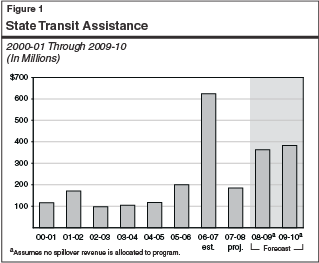Analysis of the 2007-08 Budget Bill: Transportation
The state provides assistance to regional and local transit systems in two ways through the Public Transportation Account (PTA). First, the state provides financial support for transit operations through the State Transit Assistance (STA) program. In the current year, STA receives $624 million to be allocated to over 100 transit operators statewide, largely to support operating costs. Second, the state funds transit capital improvements, such as equipment purchase and facility and track construction. The current-year budget appropriated about $700 million mainly from PTA for transit capital improvements. Since 2000, certain transit capital projects have also received funding from the Traffic Congestion Relief Fund.
For 2007-08, the budget requests appropriations totaling $1.5 billion to provide assistance to transit. The amount includes (1) $184.6 million from PTA for STA to provide operating assistance, and (2) $1.3 billion in Proposition 1B bond funds for transit capital improvements.
The Governor’s budget proposes to discontinue the allocation of spillover revenue to the State Transit Assistance (STA) program on a permanent basis. While this would result in less funding to STA in years when there would have otherwise been spillover revenue, the proposal would increase the predictability and stability of the program’s funding level from year to year.
Under current law, the STA program is allocated one-half of the revenues deposited into PTA. Historically, the PTA received revenues from two sources: (1) diesel sales tax and (2) a portion of the state sales tax on gasoline, including spillover revenue and revenue from the sales tax on 9 cents per gallon of gasoline (referred to as the Proposition 111 gasoline sales tax revenue). Since 2005-06, PTA has also received a portion of Proposition 42 gasoline sales tax revenue. Because spillover revenue depends on gasoline prices and the sales of all other goods, it is a volatile funding source both in terms of whether it is available at all, and if so, at what amount. As a result, it is difficult to project spillover revenue from year to year. For instance, as we noted in the “Funding for Transportation Programs” write-up, there was no spillover revenue for 12 out of the 15 years from 1986-87 through 2000-01. For those years, STA funding relied only on diesel sales tax revenues and Proposition 111 gasoline sales tax revenues.
Governor’s Proposal. The budget proposes to discontinue allocating spillover revenue to STA permanently, beginning in 2007-08. Any spillover revenue would instead remain in the PTA to fund other purposes. For 2007-08, these other purposes include funding the state’s intercity rail service and the Department of Transportation’s (Caltrans’) mass transportation program, as well as to fund Home-to-School transportation, regional center transportation, and pay the debt service on transportation bonds. Beyond 2007-08, any spillover revenue would provide continued funding to Home-to-School transportation in addition to intercity rail services and Caltrans’ mass transportation program.
The Governor’s proposal would result in less STA funding in years when there would have otherwise been spillover revenue. However, by not including spillover revenue in STA, the proposal would eliminate the volatility that spillover revenue creates in the program’s funding level. As a result, this would make STA funding more stable and predictable from year to year. (Please see the discussion of the Governor’s proposals for PTA use and the spillover formula in
“Funding for Transportation Programs “ in the “Crosscutting Issues” section of this chapter.)
The budget overestimates by $4.5 million the amount needed to offset the funds allocated to State Transit Assistance (STA) in 2006-07. Accordingly, we recommend increasing STA funding in 2007-08 by a corresponding amount.
The 2006 budget overestimated the amount of spillover revenue into PTA, using projections of gasoline prices that were too high. As a result, the current-year budget appropriated more to STA than is required by law. The Governor’s budget estimates that the program is allocated $102 million more than law requires, and proposes to offset that amount by reducing the 2007-08 allocation by a corresponding amount.
Offset Amount Is Overstated. Discussions with the Department of Finance indicate that the allocation in the current year is $97.5 million, instead of $102 million, more than law requires. Accordingly, the 2007-08 STA funding level should be higher, by $4.5 million.
Our projections show that beginning in 2008-09, ongoing allocations to State Transit Assistance would be sizeable, around $350 million, and increasing annually thereafter, even if the program receives no spillover revenue.
Historically, STA funding has been modest. From 1996-97 through 2005-06, program funding averaged $118 million annually. The current-year funding level of about $624 million is exceptionally high mainly due to loan repayments from the General Fund to Proposition 42 (a portion of which eventually finds its way to STA) and high spillover revenue resulting from high gasoline prices in 2006.
The budget proposes to permanently discontinue the allocation of spillover revenue to STA beginning in 2007-08. This, as we noted earlier, would result in less STA funding than current law provides, in the years when there otherwise would be spillover revenues. Nonetheless, as shown in Figure 1, we forecast that starting in 2008-09, STA would receive

sizeable allocations of over $350 million each year, more than double what it has received on average in recent history. This is because beginning in 2008-09, PTA will receive 20 percent of Proposition 42 gasoline sales tax revenue annually. Under current law, one-half of this amount, together with one-half of all other PTA revenues (from diesel sales tax and Proposition 111 gasoline sales tax) would be allocated to STA. Because gasoline and diesel sales tax revenues are substantial and increase with rising fuel sales, ongoing STA funding would be sizeable and relatively stable, even if no spillover revenue is allocated to the program as proposed by the Governor’s budget.
Return to Transportation Table of Contents,
2007-08 Budget Analysis